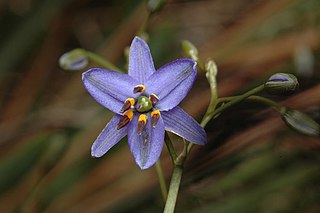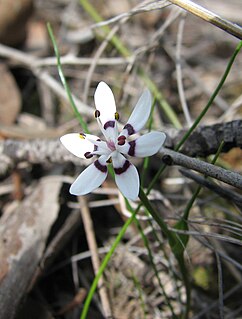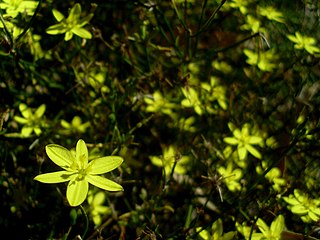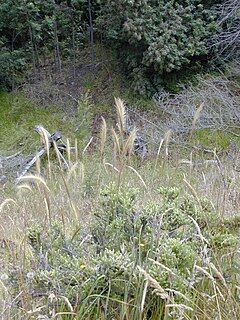
Myoporum is a genus of flowering plants in the figwort family, Scrophulariaceae. There are 30 species in the genus, eighteen of which are endemic to Australia although others are endemic to Pacific Islands, including New Zealand, and one is endemic to two Indian Ocean islands. They are shrubs or small trees with leaves that are arranged alternately and have white, occasionally pink flowers and a fruit that is a drupe.

Cordyline is a genus of about 15 species of woody monocotyledonous flowering plants in family Asparagaceae, subfamily Lomandroideae. The subfamily has previously been treated as a separate family Laxmanniaceae, or Lomandraceae. Other authors have placed the genus in the Agavaceae. Cordyline is native to the western Pacific Ocean region, from New Zealand, eastern Australia, southeastern Asia and Polynesia, with one species found in southeastern South America.

Arthropodium is a genus of herbaceous perennial plants in the subfamily Lomandroideae of the family Asparagaceae. It is native to Australia, New Zealand, New Caledonia and Madagascar.

Dichopogon strictus, commonly known as chocolate lily, is a herbaceous perennial plant species native to Australia.

Muehlenbeckia or maidenhair is a genus of flowering plants in the family Polygonaceae. It is native to the borders of the Pacific, including South and North America, Papua New Guinea and Australasia. It has been introduced elsewhere, including Europe. Species vary in their growth habits, many being vines or shrubs. In some environments, rampant species can become weedy and difficult to eradicate.

Patersonia is a genus of flowering plants in the family Iridaceae commonly known as native iris or native flag. It was first described as a genus in 1807 by Robert Brown. It is native to Australia, New Guinea, New Caledonia, and insular Southeast Asia. The genus name is a tribute to the first Lieutenant Governor of New South Wales in Australia, William Paterson.

Lomandroideae is a subfamily of monocot flowering plants in the family Asparagaceae, order Asparagales, according to the APG III system of 2009. The subfamily name is derived from the generic name of the type genus, Lomandra. The group has previously been treated as a separate family Laxmanniaceae. In the Kubitzki system, it is treated as Lomandraceae Lotsy.

Commersonia is a genus of twenty-five species of flowering plants in the family Malvaceae. Plants in this genus are shrubs or trees, occurring from Indochina to Australia and have stems, leaves and flowers covered with star-like hairs. The leaves are simple, often with irregularly-toothed edges, the flowers bisexual with five sepals, five petals and five stamens and the fruit a capsule with five valves. The genus underwent a revision in 2011 and some species were separated from Commersonia, others were added from Rulingia.

Centrolepis is a genus of small herbaceous plants in the family Restionaceae known as thorn grass scales, with about 25 species native to Australia, New Zealand, New Guinea, and south-east Asia as far north as Hainan Dao. APG III system classifies this genus in the Centrolepidaceae family.

Dianella is a genus of about forty species of flowering plants in the monocot family Asphodelaceae and are commonly known as flax lilies. Plants in this genus are tufted herbs with more or less linear leaves and bisexual flowers with three sepals more or less similar to three petals and a superior ovary, the fruit a berry. They occur in Africa, South-east Asia, the Pacific Islands, New Zealand and Australia.

Thysanotus is a genus of perennial herbs in the family Asparagaceae, subfamily Lomandroideae. They are mostly native to Australia with 45 of the 50 known species occurring in Western Australia alone, although a few species range northward into New Guinea and Southeast Asia as far north as southern China.

Dipodium, commonly known as hyacinth orchids, is a genus of about forty species of orchids native to tropical, subtropical and temperate regions of south-east Asia, New Guinea, the Pacific Islands and Australia. It includes both terrestrial and climbing species, some with leaves and some leafless, but all with large, often colourful flowers on tall flowering stems. It is the only genus of its alliance, Dipodium.

Gahnia is a genus of sedges native to China, Southeast Asia, New Guinea, Australia, New Zealand and a number of Pacific Islands. The common name is due to the toothed margins. It often forms tussocks.

Wurmbea is a genus of perennial herbs in the family Colchicaceae, native to Africa and Australia. There are about 50 species, with about half endemic to each continent.

Chamaescilla is a genus of Australian herbs in the subfamily Hemerocallidoideae within the asphodel family. They have grass-like basal leaves and tuberous roots. The flowers have six petals and six stamens. The seed capsules contain black, glossy seeds.

Tricoryne is a genus of perennial herbs in the family Asphodelaceae, subfamily Hemerocallidoideae. All species are native to Australia with two species extending to New Guinea; within Australia they occur in all 6 states and the Northern Territory.
- Tricoryne ancepsR.Br. - New Guinea, Queensland
- Tricoryne corynothecoidesKeighery - Western Australia
- Tricoryne elatiorR.Br. - Yellow Rush-lily - all 6 states plus Northern Territory
- Tricoryne humilisEndl. - Western Australia
- Tricoryne muricataBaker - Queensland
- Tricoryne platypteraRchb.f - New Guinea, Queensland
- Tricoryne simplexR.Br. - New South Wales
- Tricoryne tenellaR.Br. - Mallee Rush-lily - Western Australia, South Australia

Caesia is a genus of herbs in the family Asphodelaceae, subfamily Hemerocallidoideae, native to Australia, New Guinea, Madagascar and Southern Africa. The mostly 3-lobed seed capsules contain rounded black seeds. The genus was named in honour of Federico Cesi (1585-1630), an Italian scientist.
- Caesia alpina Hook.f. - alpine grass-lily - New South Wales, Tasmania, Victoria
- Caesia calliantha R.J.F.Hend. - blue grass-lily - New South Wales, Tasmania, Victoria, South Australia
- Caesia capensis(Bolus) Oberm. - Cape Province of South Africa
- Caesia chlorantha F.Muell. - New South Wales, Queensland, Western Australia
- Caesia micrantha Lindl. - New South Wales, Tasmania, Victoria, South Australia, Western Australia, Queensland
- Caesia occidentalis R.Br. - Western Australia
- Caesia parviflora R.Br. - pale grass-lily - Queensland, New South Wales, Tasmania, Victoria, South Australia, Western Australia
- †Caesia rigidifolia F.Muell. - Queen Victoria Springs in Western Australia but extinct. Last recorded near Zanthus in 1875.
- Caesia sabulosaBoatwr. & J.C.Manning - Cape Province
- Caesia setifera Baker - Queensland, Western Australia, Northern Territory, New Guinea
- Caesia subulataBaker - Madagascar
- Caesia viscida Keighery - Western Australia

Laxmannia is a genus of tufted perennial herbs in the family Asparagaceae, subfamily Lomandroideae, that are endemic to Australia.

Astelia is a genus of flowering plants in the recently named family Asteliaceae. They are rhizomatous tufted perennials native to various islands in the Pacific, Indian, and South Atlantic Oceans, as well as to Australia and to the southernmost tip of South America. A significant number of the known species are endemic to New Zealand. The species generally grow in forests, swamps and amongst low alpine vegetation; occasionally they are epiphytic.

Dichelachne is a genus of Australian, Indonesian, and Pacific Island plants in the grass family. They are known commonly as plumegrasses.




















